Summary
- One of the most important takeaways from 3Q23 was management's strategy for Shopee, which is to maximize long-term profitability through strong market leadership and scale.
- To achieve their long-term objective of maximizing profitability in the long run, the management team looks at three key operational factors, which are growth, current profitability and market share gain.
- Sea Limited is in an investment mode today, given rising competitive pressures to ensure it maintains its scale and market leadership for tomorrow.
- The company is investing in e-commerce live streaming and logistics to drive growth, market share gain, and improve user experience.
- I continue to see Sea Limited as an attractive investment for long-term investors given the quality of the management team and the continued investments it makes in its business to drive long-term sustainable growth and grow its competitive moat.
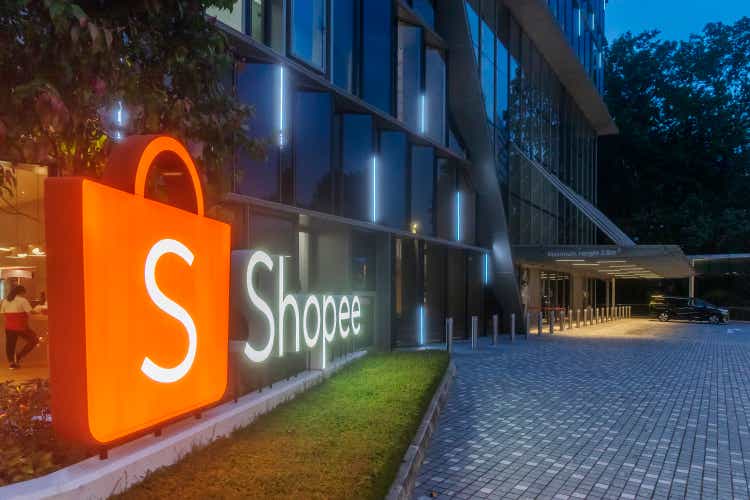
kokkai
I have looked through and reviewed the 3Q23 earnings results for Sea Limited (NYSE:SE) and in this article, I will be highlighting key points and my thoughts about the opportunity.
Was the sell-off post earnings justified?
To form a view on this, we first have to understand management's strategy and framework for making decisions, which I will cover next.
Long-term view to maximize returns for shareholders
If you listened in to the 3Q23 Sea Limited earnings call, I think that you will appreciate the deep and long-term thinking of the management team and why they make the decisions that they make in different points of time.
I think it's important to start with the why so that we understand the thinking of the management team and evaluate if they are indeed taking the right step forward.
In my view, the current investment in the e-commerce business is the right decision for the long-term potential of Shopee.
Underlying strategy for e-commerce
The management team's strategy for e-commerce is based on the principle of maximizing long-term profitability of Shopee, which will in turn maximize shareholder value in the long-term.
In order to maximize long-term profitability of the Shopee business, it requires two key ingredients like many other businesses, and these two key ingredients are a sufficient and large enough scale and strong market leadership.
I think that in the e-commerce industry, these two key ingredients are crucial to success. All over the world, we see that the successful e-commerce players have achieved this. In the United States, Amazon (AMZN) has clearly achieved scale and market leadership to bring about this long-term profitability of the business. In China, we have three large players, Alibaba (BABA), JD.com (JD) and Pinduoduo (PDD), all three of which has scale and market leadership.
For Sea Limited's Shopee, to achieve their long-term objective of maximizing profitability in the long run, the management team looks at three key operational factors, which are growth, current profitability and market share gain.
While growth leads to improved market share gain and profitability, there are periods when the management team needs to prioritize on one or more of these key operational factors which may result in an offsetting effect for another factor.
I think that having these three key operational factors framework is helpful in framing the decision-making process of Shopee.
As a result, I think it's clear that the management team in Sea Limited is focused on maximizing the long-term profitability of Shopee in the long run, which can be achieved through strong market leadership and a sufficient and large enough scale. To do so, the team tracks and improves on three key operational factors, which are growth, current profitability and market share gain.
Has the management team been consistent in applying these key principles in the past?
Now let us evaluate whether the management team has applied these principles and strategy to the business in the past.
The first period we can evaluate is the pandemic period. For Shopee, this was a great time to focus on growth given the surge in demand for e-commerce. As a result, the focus here in the pandemic period was growth and ramping up of its e-commerce operations. The pandemic period was a key one for Shopee and the focus on growth was the right decision for management to achieve significant scale in a relative short period of time. On top of that, Shopee also very clearly gained market share during the period and resulted in strong market leadership in its key markets.
The second period we can evaluate is when the rate environment changed and rates started to go up very quickly. During this period, management made decisive move to pivot Shopee to profitability as quickly as possible. In my opinion, that move was an admirable one for the company given that it was able to act so nimbly and exit markets so quickly in order to be consistent with its principle of maximizing profitability for the long-term given that capital became very expensive and more limited. This move, again, managed to ensure that Shopee was able to sustain its scale and market leadership.
My view is that management has been very adept and skillful in adapting to changing market and business environment, and done so in a manner that is consistent with its principles and strategy.
Investing in a sustainable way
CEO Forrest Li emphasized that Sea Limited is committed to maintaining a strong cash position and not rely on external funding when carrying out these investments for the long-term.
As a result, I am confident that the management team in Sea Limited is and will invest in a sustainable and nimble manner as market conditions change.
With a strong cash position and a focus on long-term sustainability of the business, I think that Sea Limited's current investments at this point in time is not a concern for me given that management is doing so at a pace that is prudent.
Management also mentioned that given that e-commerce penetration is low in most of its markets, Shopee, as the market leader in most of these markets will need to grow the whole e-commerce ecosystem, and that the team is committed to do this in a healthy and sustainable manner.
By ensuring that it has prioritizes sustainability and having a sufficient cash position, this enables Sea Limited to be nimble and act decisively when necessary, which on its own creates a competitive advantage for the business.
Current investment in a changing environment
Today, the management team continues to use the principle and strategy highlighted for its e-commerce segment.
Management is seeing a need to focus on investing in growth and market share gain, and this may mean a weaker near-term profitability to achieve this goal of maximizing long-term profitability.
The key driver for this is because the competitive landscape has intensified in Shopee's key markets. While the company can technically continue its status quo and not invest in its business given it is the market leader in these markets, the decision of needing to invest in growth today is in line with the goal of maximizing long-term profitability of the business.
If Shopee does not invest today, these new entrants in Shopee's key markets may gain market share, improve on their scale and grow in terms of market leadership. In turn, the win of these new entrants will lead to a loss for Shopee.
As a result, management's decision to invest in the e-commerce business is a vital one for the long-term profitability of the business and to maximize long-term returns for shareholders as it ensures that Shopee will be a key winner in the market share consolidation that occurs as a result of this intensified competition. As a key winner during this competitive period, the company can not only achieve sustainable profitability, but also drive other players that are unable to gain scale out of the market.
I think that the decision to invest today is the right one given that Shopee currently has a large scale, an in-depth understanding and experience in its core markets, as well as a strong localized execution across these markets.
The investment today will ensure that Shopee's competitive advantage will not diminish, but in fact, continue to grow further.
It is also important to note that the management team made the decision to invest in the growth of the e-commerce segment because they are of the view that their pivot to self-sufficiency and profitability earlier has resulted in significantly improved cash position and operational efficiency. Sea Limited has grown its cash position by about $600 million in the last year to $7.9 billion as of 3Q23.
This strong cash position enables Shopee to have sufficient resources to invest in growth while still having a strong balance sheet to operate the business in the long run sustainably.
Where is Shopee investing in today?
Third, live streaming has become increasingly popular among sellers, buyers, and creators in our markets. These tailwinds give us a very good opportunity to build our e-commerce content ecosystem efficiently. We believe live streaming e-commerce will become a sizable and profitable part of our platform and extend our long-term growth potential.
Investments in e-commerce live streaming
In 3Q23 specifically, Shopee made a strong investment in e-commerce live streaming and has seen some encouraging results.
Shopee increased the collaborations with content creators and live streaming sellers in 3Q23 and in turn, this has resulted in deeper engagement with buyers and also acquired new buyers along the way as well.
Shopee has also increased efforts to help sellers and creators get started on Shopee Live to increase their participation in the e-commerce live streaming initiative.
Here are some statistics from the management team in 3Q23 that showed some of the traction and benefits that they are seeing with e-commerce live streaming.
Firstly, in Southeast Asia, more than 10% of the total order volume for October was from live streaming.
Secondly, in Indonesia, Shopee saw that 20% of daily active users watched live streaming in October.
Thirdly, as a result of the efforts to help sellers and creators get on board with live streaming, Shopee saw the number of average daily unique streamers, total daily hour streams, and the number of daily stream sessions grow by more than three times in October compared to June.
Fourth, these streamers are also becoming more engaged and using the platform longer as the stream duration grew by more than a third during the same period.
The focus for Shopee in terms of investment for live streaming has been very targeted at key categories like fashion and health and beauty.
The investment has been focused on these categories because they bring higher margins and also they tend to benefit from the engagement from live streaming, which will lead to better sales conversion and improved market leadership in these categories.
Management reiterated that they continue to focus on the investment efficiency and unit economics of the business and based on what they have seen, they continue to see that e-commerce live streaming can be a meaningful part its business.
Investments in logistics
Management has also invested in logistics in the quarter, which is meant to drive down logistics costs and also improve user experience.
In 3Q23, the platform logistics costs per order has fallen by 17% from the prior year in its Asia markets, highlighting the benefits of this investment in logistics.
I think that this is one really important area of investment for Shopee because as it focuses on scale and market share gain, this should drive logistics costs down and in turn, when logistics costs go down, both buyers and sellers will benefit from the lower shipping costs, further improving Shopee's scale and market share gain potential and competitive advantage.
This focus on investment in logistics results in Shopee being able to expand the coverage of its logistics network in more of its markets so that it benefits more sellers and buyers.
Thus, investment in logistics will also involve expanding its network of sorting centers, improving routing for more efficient and faster deliveries, which will in turn expand its logistics coverage.
Brazil
Brazil continues to be a key market for Shopee in 3Q23, not just on a growth front, but also on the user economics front. Shopee is investing in user acquisition and category expansion in the Brazil market as it remains in a relatively early stage in the market and needs to invest in this market to continue to grow.
As a result, management is committed to improving operational efficiency there by investing in logistics, while also taking a balanced approach in terms of investing in growth in Brazil.
It is interesting how Shopee has already reached sufficient scale and cost efficiency in Brazil to be profitable.
However, in-line with its principle and strategy of maximizing long-term profitability of its e-commerce business, management remains focused on continuing to grow and invest in growth in the market.
3Q23 results
While revenues, along with e-commerce and digital financial services segment beat expectations, digital entertainment segment adjusted EBITDA missed.
On a Group level, GAAP revenues came in at $3.3 billion, up 5% from the prior year and up 7% sequentially. This beat consensus expectations by 3%.
The beat was largely driven by GAAP Digital Entertainment revenues, which came in at $592 million, beating expectations by 17%.
GAAP e-commerce revenue came in at $2.2 billion, up 16.2% from the prior year, which is in-line with consensus expectations.
Digital financial services segment GAAP revenue came in at $446 million, up 37% from the prior year.
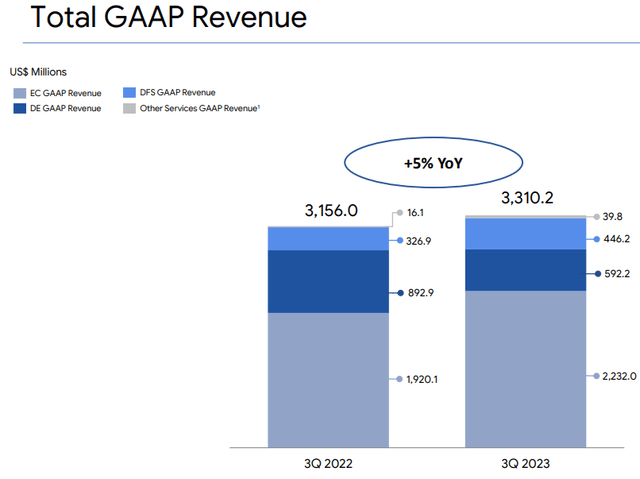
GAAP revenue (Sea Limited)
Adjusted EBITDA for the Group came in at $35 million, beating expectations of negative $0.6 million.
Adjusted EBITDA for the e-commerce segment was negative $347 million, largely in-line with consensus expectations.
Adjusted EBITDA for the digital entertainment segment fell 19% from the prior year to $234 million and adjusted EBITDA margin came in at 52% of bookings.
Adjusted EBITDA for the digital financial services came in at $166 million, beating consensus expectations by 14%. At the end of 3Q23, the gross loan receivables grew 5.3% sequentially to $2.4 billion and net of allowance for credit losses came in at $288 million. Non-performing loans past due by more than 90 days as percentage of total gross loan receivables improved to around 1.6%.
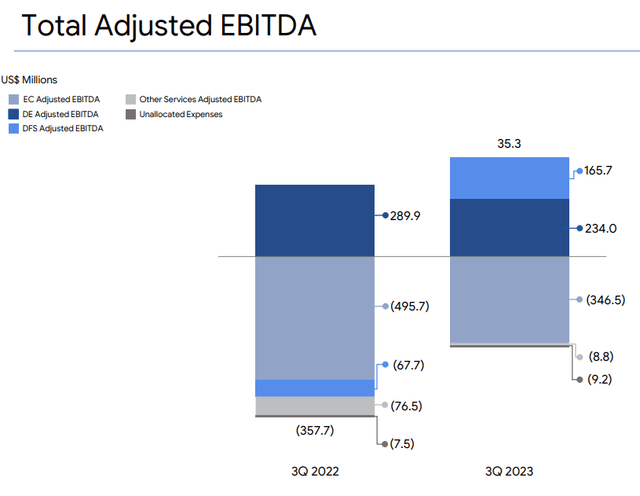
Adjusted EBITDA (Sea Limited)
However, non-GAAP net income came in at $31 million, below consensus expectations of $181 million.
E-commerce segment
The e-commerce revenue came in at $1.9 billion in 3Q23, with the core marketplace revenue, which comprises of transaction-based fees and advertising revenue, came in at $1.3 billion, up 32% from the prior year. This was contributed by increases in both commission rates and in advertisement uptake by sellers.
Value added services came in at $0.6 billion, down 4% from the prior year as it related to logistics service revenues and as mentioned above, Shopee managed to lower logistic costs for seller in the quarter.
As Shopee is in an investment mode, adjusted EBITDA went back to a loss of $347 million in 3Q23 and while it is better than the adjusted EBITDA loss of $496 million in 3Q22, it is a fa cry from the positive adjusted EBITDA of $150 million achieved last quarter.
Asia market had an adjusted EBITDA loss of $306 million while the other markets had an adjusted EBITDA loss was $40 million. From a year-on-year basis, the other markets segment narrowed adjusted EBITDA losses meaningfully while that of the Asia market accelerated.
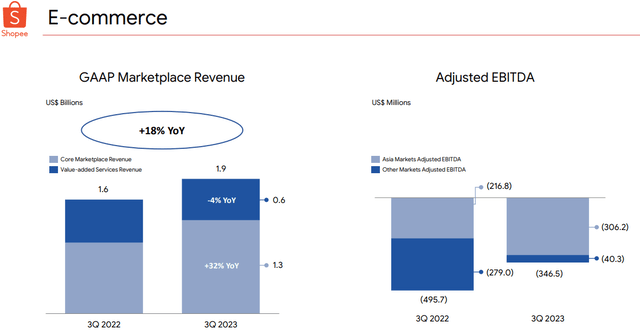
E-commerce metrics (Sea Limited)
In particular, the contribution margin loss per order improved 91% from the prior year to reach $0.10, as a result of improving efficiency and monetization in the region.
When assessing the effectiveness of the investments made into the e-commerce segment, Shopee looks at how its scale and market leadership is trending and in 3Q23, both showed growth.
In 3Q23, average active monthly buyers grew 11% sequentially as both buyer retention and order frequency also improved.
Shopee's gross orders and GMW also accelerated sequentially by 24% and 11% sequentially, highlighting an increase in market share.
In particular, Tokopedia's (OTCPK:GTOFF) GMV grew by 6% sequentially, but at a flat EBITDA margin of negative 0.4% of GMV.
As a result, the near-term results show an early sign that the current investments made in the e-commerce segment are taking fruit and helping the company achieve the long-term profitability it is working towards.
While no guidance was provided, management said that they will continue to invest in 4Q23 in the holiday shopping season to grow market share, acquire new users and improve its content ecosystem.
Interesting, in the last one and a half month with the double 11 sales, GMV reached more than $1 billion.
Digital Entertainment segment
Digital Entertainment segment bookings for 3Q23 came in at $448 million, down 33% from the prior year and up 1% sequentially.
Quarterly active users were stable at 544 million while quarterly paying users was relatively weaker at 41 million. As a result, the quarterly paying ratio fell to 7.5% in 3Q23.
Management added that the sequential decline in quarterly paying users was due to seasonality impact on gaming performance, which may indicate further stabilization of gaming performance. While school reopening and less holidays may affect user engagement, management still sees improvement in user retention.
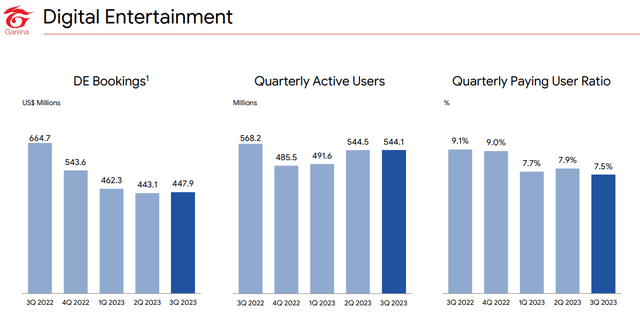
Digital entertainment metrics (Sea Limited)
Digital Entertainment adjusted EBITDA came in at $234 million, down 19% from the prior year and down 2% sequentially.
Adjusted EBITDA margin for Digital Entertainment in 3Q23 was 52% of bookings, compared to 54% from the prior quarter and 43.6% from the prior year.
In particular, my view is that the stabilization of bookings for Digital Entertainment, quarterly active users and adjusted EBITDA on a sequential basis is positive given that 3Q23 is usually the period where schools reopened in multiple key markets.
For Free Fire specifically, management continues to see stable trends in both user and monetization metrics, which was also good to see. The Garena team has been focused on improving user experience in 2023, like reducing loading times and enhancing the social experience through an improved guild system, and that has helped to result in improved user engagement along with better user retention.
I think it is also worth noting that Free Fire was the most downloaded mobile game globally in 3Q23, based on Sensor Tower data, which provides a nice leading indicator into the interest and demand for Free Fire.
Management also provided additional color on its other published games in its portfolio, where it sees healthy trends.
Call of Duty Mobile reached its highest every quarterly bookings as a result of content collaboration and improvements to the game experience.
For Arena of Valor, Garena added new content which has received very positive user feedback. This in turn lead to a new peak in the quarterly active users for the game.
Tencent partnership continues.
While there is no expectation that this would otherwise be the case, management mentioned that the agreement with Tencent for the right of first refusal agreement has been renewed under the existing terms.
This agreement is expected to be renewed every year after the five-year agreement unless terminated by either Tencent or Garena.
Management continues to focus on strengthening the game pipeline with both published and self-developed games.
Digital financial services
Increasingly, I think that SeaMoney is becoming a more important part of Sea Limited's core business as it is starting to contribute meaningfully to top and bottom line of the company.
The focus for SeaMoney today continues to be to introduce more comprehensive products and services for its users in different markets and grow the synergy with other businesses like Shopee.
One example management gave was that for its banks in Singapore, Indonesia and the Philippines, the company has seen strong adoption of its direct debit services, allowing users to pay on Shopee directly with from its own banks.
I think that this is an excellent example of the synergies that are starting to develop between different businesses, and I think this will only continue to grow.
How efficient is the current sales and marketing spend?
While management has only just started its investments into the e-commerce space, we can still look at how the sales and marketing spend is translating to e-commerce revenues.
While the sales and marketing efficiency number for 3Q23 of 259% is relatively low, I think that the period to which we compare it to is important.
Recall above that in the pandemic period, the company was in a growth or investment mode, while it pivoted to profitability mode in 2022.
The result of the pivot to profitability mode in 2022 resulted in very high sales and marketing efficiency as the company dialed back on sales and marketing spend, particularly so from 4Q22 to 2Q23.

Sea Limited sales and marketing and revenue growth for the e-commerce segment (Author generated)
However, we just have to look at the beginning of the pandemic period in 1Q20 to see that in periods where the company is in an investment mode, sales and marketing efficiency can go down to 152%, as was the case in 1Q20.
Thus, from a sales and marketing efficiency point of view for 3Q23 at least, it does reflect that the company is in an investment mode, but it is still at a healthy level considering that.
In addition, I think we have to realize that there may be a lag in terms of the effect of the sales and marketing spend. For example, $1 in sales and marketing spend in 1Q20 may only result in returns on investment in 2Q20 or later. We can see that the investment mode that the company was in during the pandemic has benefited e-commerce revenues subsequently in 2022.
While the 16% e-commerce revenue growth looks small relative to the 50% growth in sales and marketing spend in 3Q23, I think we have to recognize that e-commerce revenues will lag sales and marketing spend and that there was a lower base effect for the sales and marketing spend given it was in a profitability mode one year earlier.
How are the results of the investment thus far?
In terms of the investments made in the e-commerce live streaming space, management said that they have seen a significant improvement in the economics of live streaming.
In fact, they are satisfied with their achievements thus far as they have achieved the market share gain, they targeted while at better economics than anticipated. The momentum in live streaming has been growing both from the seller and creator front, as well as the buyer front.
Overall, I guess to answer your question, we are very happy with what we have achieved. Essentially, we achieved the market share gain that we wanted with much better economics than we thought. We also have seen good traction in live stream. The tick rate has been faster than we thought for the live stream services.
I would also highlight that management shared that they would continue to invest in 4Q23 given it is the holiday and shopping season, which makes it the best time to acquire new users and market share.
However, one of the most encouraging signs to me is that for the double 11 sale which happened in 4Q23, management shared that they have achieved more than 1 billion GMV and that result was better than what management was expecting.
In addition, when we look at the ban of TikTok Shop in Indonesia, it only happened in October 2023. What this means is that while it provided no tailwind in 3Q23, it will likely bring some incremental benefit in 4Q23.
Valuation
As a result of the increased investments, I am revising the financial forecasts for the company and rolling forward to the next 5-year period.
Specifically, given that there is no clarity on when this investment mode will end, I am assuming that in 2H24, we will start to see this taper off and thus, in 2025, we will see an inflection in profitability.
For the 1-year price target, I assume 35x 2024 P/E.
Thus, the 1-year price target is revised to $59.
The higher 2024 P/E multiple is a result of a higher earnings growth expected in 2025 due to elevated investment spend tapering off in 2024.
Conclusion
To go back to the question I asked at the start of the article: Is the sell-off justified?
After understanding the strategy and principles behind the decision, I am of the view that things are certainly not as bad as it seems.
Yes, Sea Limited is going back to investment mode, but its balance sheet and financial strength is much stronger than it was compared to one year ago and it is doing so to maximize long-term profitability through growing its scale and market leadership.
I would have actually considered exiting the Sea Limited position if management did not go into investment mode last quarter. If it did not start investing in its business during a time when new entrants are coming into the space and competition ramps up, it will only lose its competitive advantage and the leadership position it has built during the pandemic.
Since I think that going into investment mode is necessary to gain market share and scale, there are trade-offs I am willing to accept, and that is to sacrifice near-term profitability for long-term profitability.
There is no doubt that as Sea Limited invests in its business, expenses will go up. However, the company is focused on investment efficiency and sustainability of the business and are thus prudent with the capital and financial resources that they have.
A company that does not invest in its business has no chance of survival but a company that invests in its business prudently has the chance of long-term sustainability.
Editor's Note: This article discusses one or more securities that do not trade on a major U.S. exchange. Please be aware of the risks associated with these stocks.
Comments